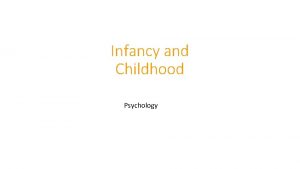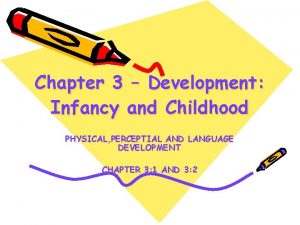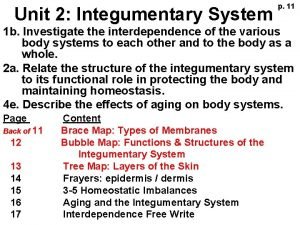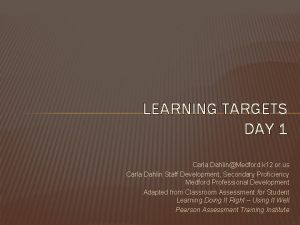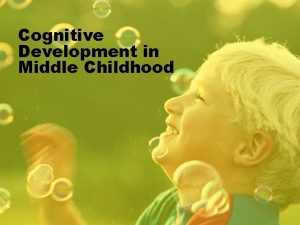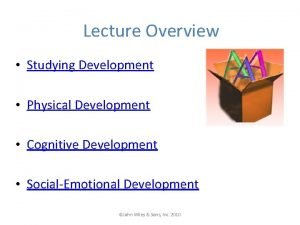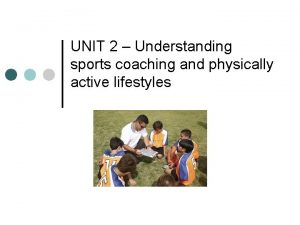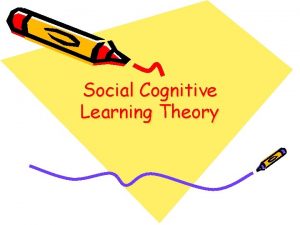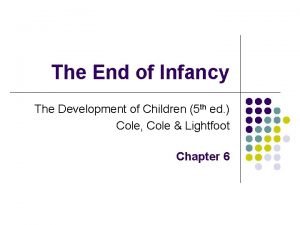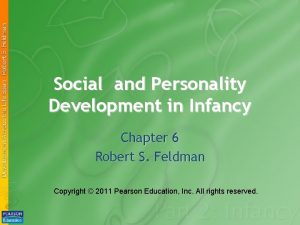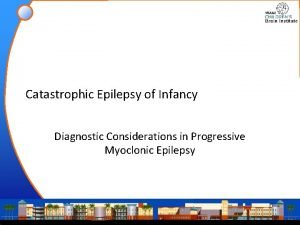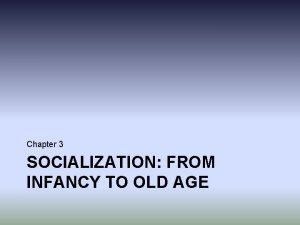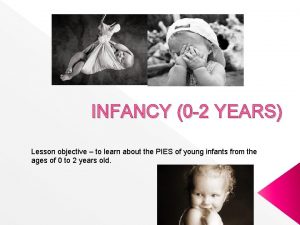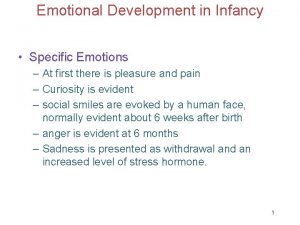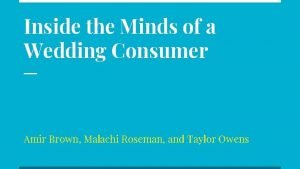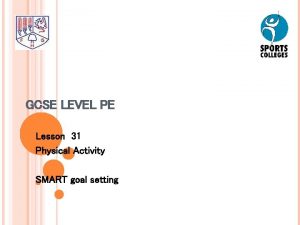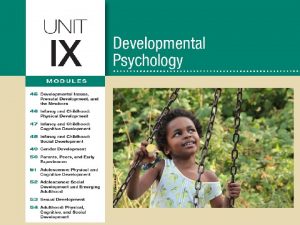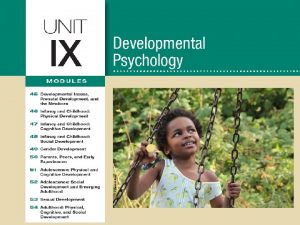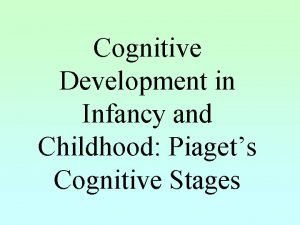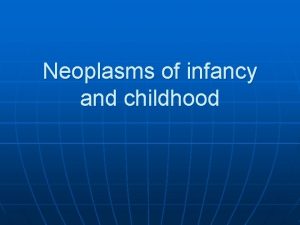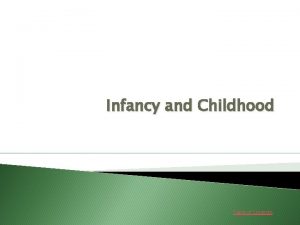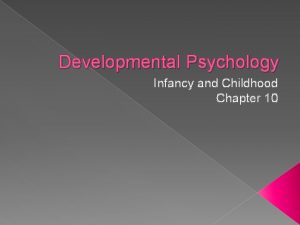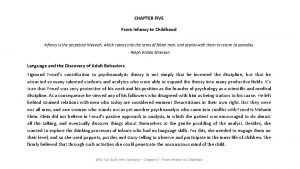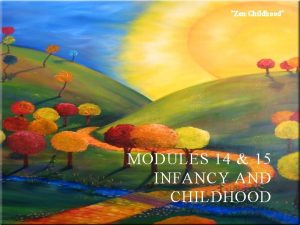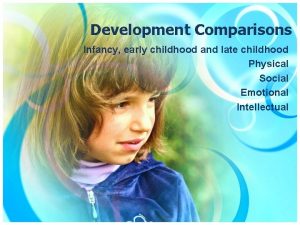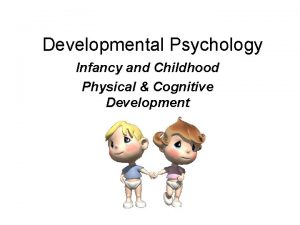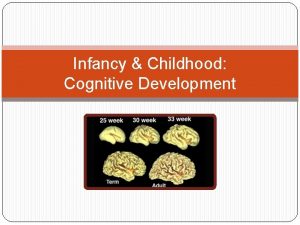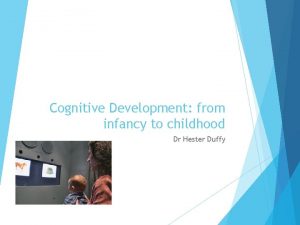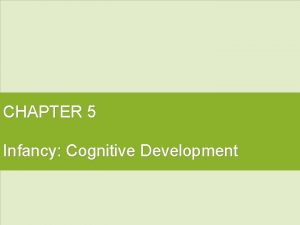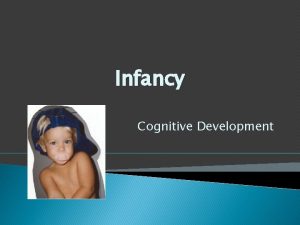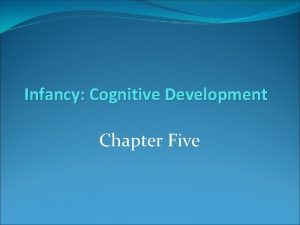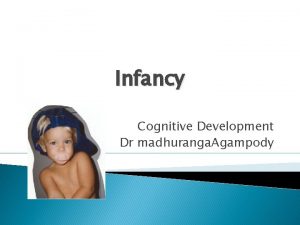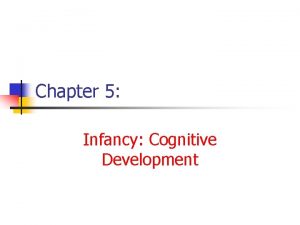Learning Targets Module 47 Infancy and Childhood Cognitive


![Once conscious, how does the mind grow? Developmental psychologist Jean Piaget [pee-ah-ZHAY] spent his Once conscious, how does the mind grow? Developmental psychologist Jean Piaget [pee-ah-ZHAY] spent his](https://slidetodoc.com/presentation_image_h/090b9f95b3b81419c543fd08c43f545f/image-3.jpg)





























































- Slides: 64


Learning Targets Module 47 Infancy and Childhood: Cognitive Development 47 -1 Describe how a child’s mind develops from the perspectives of Piaget, Vygotsky, and today’s researchers. 47 -2 Discuss autism spectrum disorder and its effect on development.
![Once conscious how does the mind grow Developmental psychologist Jean Piaget peeahZHAY spent his Once conscious, how does the mind grow? Developmental psychologist Jean Piaget [pee-ah-ZHAY] spent his](https://slidetodoc.com/presentation_image_h/090b9f95b3b81419c543fd08c43f545f/image-3.jpg)
Once conscious, how does the mind grow? Developmental psychologist Jean Piaget [pee-ah-ZHAY] spent his life searching for the answer. He studied the development of children’s cognition— all the mental activities associated with thinking, knowing, remembering, and communicating.

What was Piaget’s belief about cognitive development? Piaget’s studies led him to believe that a child’s mind develops through a series of stages, in an upward march from the newborn’s simple reflexes to the adult’s abstract reasoning power. For example, an 8 -year-old can comprehend things a toddler cannot, and an adult can understand nuances and abstract concepts that a child cannot.

How do we make sense of our experiences? Piaget’s core idea was that our intellectual progression reflects an unceasing struggle to make sense of our experiences. To this end, the maturing brain builds schemas, concepts or mental molds into which we pour experiences.

What is your schema (idea or model) … Of a dog? Of a firefighter? Of a teacher? Of friendship? Talk with your partner about the qualities, characteristics and ideas that make up your understanding of the items above.

What is a schema? A schema (or an idea or model) for “doggy” might include: four legs, furry coat, long tail, wet tongue, cold nose, friendly, and fun.

How does a child add new items to existing schemas? When first seeing a “cat”, a child may think of it in relation to their schema of “doggy”…four legs, furry, long tail, cold nose… and assimilate (or add) this new example into their existing schema.

What if a new example doesn’t fit our existing schema? If the new example does not quite fit the schema, we receive correction and need to modify our understanding. This is called accommodation.

How does accommodation increase cognition? By accommodating (or changing) the existing schema and adding new characteristics to distinguish “doggy” from “cat”, we begin to increase cognitive understanding of our world.

Put it all together. Talk through the steps in the image above using your new vocabulary.

Schemas develop throughout the lifespan. Although Piaget studied the development of schemas, and the assimilation and accommodation of them, in children, this process continues throughout our lives as we bring new information into our experience. Let’s consider some changes to schemas that we may have accommodated in later life.

How has our schema of “love” changed over time? A generation ago, most people had a schema of marriage as a union between a man and a woman.

and today… In 2001, The Netherlands was the first country to change its marriage laws to accommodate same-sex marriage. Today, more than 20 other countries have also legalized same-sex marriage.

What schemas are being accommodated? In the image above, what additional schemas are being accommodated (or changed? )

AP® Exam Tip 1 Be able to identify what it means to assimilate and accommodate schemas. Students have confused these terms on the AP® exam In the past.

What are Piaget’s four stages of cognitive development? Piaget believed that children construct their understanding of the world while interacting with it. In Piaget’s view, cognitive development consisted of four major stages—sensorimotor, preoperational, concrete operational, and formal operational.

What is the sensorimotor stage? in Piaget’s theory, the stage (from birth to nearly 2 years of age) during which infants know the world mostly in terms of their sensory impressions (what they see, hear, etc. )and motor activities (how they move)

What is object permanence? Young infants lack object permanence—the awareness that objects continue to exist even when not perceived.

How did Piaget test object permanence? Very young babies seem to live in the present: out of sight is out of mind. In one test, Piaget showed an infant an appealing toy and then covered it with his hat. Before the age of 6 months, the infant acted as if the toy ceased to exist. By 8 months, infants begin exhibiting memory for things no longer seen and search for the toy. They acquire object permanence.

Criticism of Piaget Researchers believe Piaget and his followers underestimated young children’s competence and that infants are smarter than Piaget appreciated. Young children think like little scientists. They test ideas, make causal inferences, and learn from statistical patterns. (Gopnik et al. , 2015)

Consider this research… Renée Baillargeon devised impossible scenes for infant subjects to view, such as a car seeming to pass through a solid object, a ball stopping in midair, or an object violating object permanence by magically disappearing. Baillargeon saw that infants look longer at and explore those impossible scenes. Why do infants show this visual bias? Because impossible events violate infants’ expectations. (Baillargeon, 2008; Shuwairi & Johnson, 2013; Stahl & Feigenson, 2015)

Do infants have math sense? Psychologist Karen Wynn showed 5 -month-olds one or two objects then she hid the objects behind a screen, and visibly removed or added one.

What were the results? When she lifted the screen, the infants sometimes did a double take, staring longer when shown a wrong number of objects. (Wynn, 1992, 2000, 2008)

What is the preoperational stage? in Piaget’s theory, the stage (from about 2 to 6 or 7 years of age) during which a child learns to use language but does not yet comprehend the mental operations of concrete logic.

What is conservation? the principle (which Piaget believed to be a part of concrete operational reasoning) that properties such as mass, volume, and number remain the same despite changes in the forms of objects

How did Piaget test for conservation? This visually focused preoperational child does not yet understand the principle of conservation. When the milk is poured into a tall, narrow glass, it suddenly seems like “more” than when it was in the shorter, wider glass. In another year or so, she will understand that the amount stays the same.

1. What Would You Answer? Which of the following would indicate that a child understood conservation? A. She would continue to seek a toy hidden under a blanket. B. She would “hide” in a game of hide-and-seek by covering her eyes with her hands. C. She would believe that a clay snake would have the same amount of clay as the clay ball that was used to make it. D. She would recognize that 7 + 3 involves the same mathematical relationship as 10 – 7. E. She would be able to comprehend the logic of ifthen statements.

What is pretend play? the acting out of stories which involve multiple perspectives, the playful manipulation of ideas and emotions, and the use of symbols

What research has been conducted on symbolic function in cognitive development? Psychologist Judy De. Loache showed children a model of a room and hid a miniature stuffed dog behind its miniature couch. The 2½-year-old subjects easily remembered where to find the miniature toy, but they could not use the model to locate an actual stuffed dog behind a couch in a real room. Three-year-olds—only 6 months older—usually went right to the actual stuffed animal in the real room, showing they could think of the model as a symbol for the room.

What is egocentrism? in Piaget’s theory, the preoperational child’s difficulty taking another’s point of view A 4 -year-old girl shows her grandpa “a match” on two memory game cards with matching pictures— that faced her, not grandpa.

What are examples of egocentrism? Asked to “show Mommy your picture, ” 2 -year-old Gabriella holds the picture up facing her own eyes. Three-year-old Gray makes himself “invisible” by putting his hands over his eyes, assuming that if he can’t see his grandparents, they can’t see him. 4 -year-old Norah “shows” her aunt her new toys over a telephone call, thinking her aunt can see them too.

AP® Exam Tip Careful! Egocentric is not the same as egotistical. Egocentric means you can’t take someone else’s point of view. Egotistical means you’re pretty full of yourself.

What is theory of mind? people’s ideas about their own and others’ mental states—about their feelings, perceptions, and thoughts, and the behaviors these might predict

How does theory of mind reveal itself? With time, the ability to take another’s perspective develops. Children come to understand what made a playmate angry, when a sibling will share, and what might make a parent buy a toy. They begin to tease, empathize, and persuade. And when making decisions, developing children use their understanding of how their actions will make others feel. (Repacholi et al. , 2016)

How is theory of mind tested? Children viewed a doll named Sally leaving her ball in a red cupboard. Another doll, Anne, then moved the ball to a blue cupboard.

When Sally returns, where will she look for the ball? When asked the question above, 85% of the children in the study answered the question correctly. This showed that although they subjects knew the ball had been moved, they demonstrated theory of mind in knowing that Sally would NOT have known. (Baron-Cohen, 1985)

What is the concrete operational stage? In Piaget’s theory, the stage of cognitive development (from about 7 to 11 years of age) during which children gain the mental operations that enable them to think logically about events.

child humor Mr. Jones went into a restaurant and ordered a whole pizza for his dinner. When the waiter asked if he wanted it cut into 6 or 8 pieces, Mr. Jones said, “Oh, you’d better make it 6, I could never eat 8 pieces!” (Mc. Ghee, 1976) This type of joke would be readily understood by a child in the concrete operations stage.

What is the formal operational stage? In Piaget’s theory, the stage of cognitive development (normally beginning about age 12) during which people begin to think logically about abstract concepts

What characterizes the formal operational stage? By age 12, our reasoning expands from the purely concrete (involving actual experience) to encompass abstract thinking (involving imagined realities and symbols). As children approach adolescence, said Piaget, they can ponder hypothetical propositions and deduce consequences: If this, then that. Systematic reasoning, what Piaget called formal operational thinking, is now within their grasp.

2. What Would You Answer? Which of the following cognitive abilities is possible only at the formal operational stage? A. Reversing arithmetic operations. B. Using a theory of mind to predict the behavior of others. C. Using hypothetical situations as the basis of moral reasoning. D. Using symbolic thinking for pretend play. E. Understanding basic physics to recognize impossible situations.

Put it all together Work with a partner to see if you can fill in the missing information from this chart on the stages of Piaget’s theory of cognitive development.

Who was Lev Vygotsky? Vygotsky, pictured here with his daughter, was a Russian developmental psychologist. He studied how a child’s mind feeds on the language of social interaction.

How did Piaget’s view of cognitive development differ from that of Vygotsky? As Piaget was forming his theory of cognitive development, Russian psychologist Lev Vygotsky was also studying how children think and learn. Where Piaget emphasized how the child’s mind grows through interaction with the physical environment, Vygotsky emphasized how the child’s mind grows through interaction with the social environment. If Piaget’s child was a young scientist, Vygotsky’s was a young apprentice.

What is scaffolding? a framework that offers children temporary support as they develop higher levels of thinking By giving children new words and mentoring them, parents, teachers, and other children provide a temporary scaffold from which children can step to higher levels of thinking. (Renninger & Granott, 2005)

What was Vygotsky’s view of child cognitive development? Effective mentoring occurs when children are developmentally ready to learn a new skill. For Vygotsky, a child’s zone of proximal development is the zone between what a child can and can’t do— it’s what a child can do with help. Children learn best when their social environment presents them with something in the sweet spot between too easy and too difficult.

3. What Would You Answer? Describe how Lev Vygotsky viewed the role of the following in a child’s cognitive development: § language § scaffolding § zone of proximal development How did his theory differ from that of Jean Piaget?

Apply your learning. Can you think of an example from your own childhood, or perhaps that of a sibling, that illustrates one of theories of cognitive development discussed in this section? Talk with your partner.

What is autism spectrum disorder(ASD)? a disorder that appears in childhood and is marked by significant deficiencies in communication and social interaction, and by rigidly fixated interests and repetitive behaviors.

What is the prevalence of autism spectrum disorder(ASD)? Once believed to affect 1 in 2500 ASD now gets diagnosed in 1 in 68 American children by age 8. But the reported rates vary by place, with New Jersey having four times the reported prevalence of Alabama, while Britain’s children have a 1 in 100 rate, and South Korea’s 1 in 38 (CDC, 2014; Kim et al. , 2011; NAS, 2011).

What characterizes autism spectrum disorder? The underlying source of ASD’s symptoms seems to be poor communication among brain regions that normally work together to let us take another’s viewpoint. From age 2 months on, as other children spend more and more time looking into others’ eyes, those who later develop ASD do so less and less. (Jones & Klin, 2013) People with ASD are said to have an impaired theory of mind. (Rajendran & Mitchell, 2007; Senju et al. , 2009)

When Sally returns, where would she look for the ball? Only 20% of children with autism answered the question correctly in Baron-Cohen’s 1995 study compared to 85% of non-impaired children. Most answered that Sally would look in the blue cupboard, evidencing that they knew the ball had been moved, but not recognizing that Sally did not know this.

How does the experience of ASD differ along the spectrum? ASD has differing levels of severity. About half of people with ASD experience a “fair” or even “good” outcome. (Steinhausen et al. , 2016) Some generally function at a high level. They have normal intelligence, often accompanied by exceptional skill or talent in a specific area, but deficient social and communication skills and a tendency to become distracted by irrelevant stimuli. (Remington et al. , 2009) Those at the spectrum’s more severe end struggle to use language.

What biological factors (nature) do or do NOT contribute to ASD? Studies suggest that the prenatal environment matters, especially when altered by maternal infection and inflammation, psychiatric drug use, or stress hormones (NIH, 2013; Wang, 2014) Childhood vaccinations do not contribute to ASD. (Taylor et al. , 2014) Biological factors, including genetic influences and abnormal brain development, contribute to ASD. (Colvert et al. , 2015; Makin, 2015; Tick et al. , 2015)

Is a diagnosis of ASD given more often for boys or girls? ASD afflicts about three boys for every girl. (Loomes et al. , 2017) Psychologist Simon Baron-Cohen believes this is because boys are often “systemizers. ” They tend to understand things according to rules or laws, as in mathematical and mechanical systems. Girls, he contends, are naturally predisposed to be “empathizers. ” They tend to excel at reading facial expressions and gestures. (van Honk et al. , 2011)

What research did Baron-Cohen conduct on ASD? Baron-Cohen and his Cambridge University colleagues collaborated with Britain’s National Autistic Society and a film production company. Knowing that television shows with vehicles have been popular among kids with ASD, they created animations with toy vehicle characters in a pretend boy’s bedroom, grafting emotion-conveying faces onto toy trams, trains, and tractors.

What happens in the television show? After the boy leaves for school, the characters come to life and have experiences that lead them to display various emotions.

What happened next? After viewing the television programming, the child subjects were asked to match the correct face with the story: (“The neighbor’s dog has bitten people before. He is barking at Louise. Point to the face that shows how Louise is feeling”).

What were the results of this research? The children were surprisingly able to generalize what they had learned to a new, real-life context. By the intervention’s end, their previously deficient ability to recognize emotions on real faces now equaled that of children without ASD. (Baron-Cohen, 2007; Golan et al. , 2010)

Learning Target 47 -1 Review Describe how a child’s mind develops from the perspectives of Piaget, Vygotsky, and today’s researchers. § In his theory of cognitive development, Jean Piaget proposed that children actively construct and modify their understanding of the world through the processes of assimilation and accommodation. Children form schemas that help them organize their experiences. § Progressing from the simplicity of the sensorimotor stage of the first two years, in which they develop object permanence, children move to more complex ways of thinking.

Learning Target 47 -1 Review cont. Describe how a child’s mind develops from the perspectives of Piaget, Vygotsky, and today’s researchers. § In the preoperational stage (age 2 -6/7), children develop a theory of mind, but are egocentric and are unable to perform simple logical operations. § By age 7, children enter the concrete operational stage and are able to comprehend the principle of conservation. § By age 12, children enter the formal operational stage and can reason systematically.

Learning Target 47 -1 Review, cont. Describe how a child’s mind develops from the perspectives of Piaget, Vygotsky, and today’s researchers. § Research supports the sequence Piaget proposed, but it also shows that young children are more capable, and their development is more continuous, than he believed. § Lev Vygotsky’s studies of child development focused on the ways a child’s mind grows by interacting with the social environment. Parents and caretakers provide temporary scaffolds enabling children to step to higher levels of learning.

Learning Target 44 -2 Review Discuss autism spectrum disorder and its effect on development. § Autism spectrum disorder (ASD) is a disorder marked by social deficiencies and repetitive behaviors. § Genetic influences, abnormal brain development, and the prenatal environment—especially when altered by infection, drugs, or hormones—likely contribute to ASD. § An impaired theory of mind makes it difficult for those with ASD to understand others’ point of view. § People with ASD experience different severities of the disorder. Some function at a high level, while others struggle to use language.
 Module 47 infancy and childhood cognitive development
Module 47 infancy and childhood cognitive development Module 47 infancy and childhood cognitive development
Module 47 infancy and childhood cognitive development Early childhood and middle childhood
Early childhood and middle childhood Module 46 infancy and childhood physical development
Module 46 infancy and childhood physical development Social development in infancy and childhood
Social development in infancy and childhood Infancy and childhood psychology
Infancy and childhood psychology Infancy and childhood physical development
Infancy and childhood physical development Chapter 10 infancy and childhood
Chapter 10 infancy and childhood Chapter 10 infancy and childhood
Chapter 10 infancy and childhood Psychology chapter 10 infancy and childhood
Psychology chapter 10 infancy and childhood Lesson quiz 3-2 infancy and childhood
Lesson quiz 3-2 infancy and childhood Chapter 5 cognitive development in infancy and toddlerhood
Chapter 5 cognitive development in infancy and toddlerhood Infancy childhood adolescence adulthood old age
Infancy childhood adolescence adulthood old age Writing learning targets
Writing learning targets Learning targets
Learning targets Druggist fold definition
Druggist fold definition Knowledge targets examples
Knowledge targets examples Learning targets knowledge, reasoning, skill product
Learning targets knowledge, reasoning, skill product Learning targets helping students aim for understanding
Learning targets helping students aim for understanding Cognitive development of late childhood
Cognitive development of late childhood Cognitive and non cognitive religious language
Cognitive and non cognitive religious language Early childhood is ____ for language learning
Early childhood is ____ for language learning Cognitive development in middle childhood
Cognitive development in middle childhood Cognitive development in childhood
Cognitive development in childhood Slidetodoc. com
Slidetodoc. com Intellectual definition health and social care
Intellectual definition health and social care Objectives of a warehouse
Objectives of a warehouse Identifying market segments and targets chapter 9
Identifying market segments and targets chapter 9 Identifying market segments and targets
Identifying market segments and targets Identifying market segments and targets chapter 9
Identifying market segments and targets chapter 9 Five patterns of target market selection
Five patterns of target market selection Identifying market segments and targets
Identifying market segments and targets Pituitary hormones and their targets
Pituitary hormones and their targets Smarterbalanced.alohahsap.org
Smarterbalanced.alohahsap.org Prizm segmentation scheme
Prizm segmentation scheme Cognitive associative and autonomous stages of learning
Cognitive associative and autonomous stages of learning Social and cognitive factors in learning
Social and cognitive factors in learning Cuadro comparativo e-learning m-learning b-learning
Cuadro comparativo e-learning m-learning b-learning Infancy period
Infancy period Socioemotional development in infancy
Socioemotional development in infancy Chapter 7 human growth and development
Chapter 7 human growth and development Stages of development and growth
Stages of development and growth Infancy
Infancy Personality development in infancy
Personality development in infancy Infancy physical changes
Infancy physical changes Personality development in infants
Personality development in infants Catastrophic epilepsy infancy
Catastrophic epilepsy infancy The cases of anna, isabelle, and genie
The cases of anna, isabelle, and genie Pies in infancy
Pies in infancy Pavlik harness
Pavlik harness Emotional development in infancy
Emotional development in infancy Age
Age Messianic prophecies fulfilled in the infancy narratives
Messianic prophecies fulfilled in the infancy narratives C device module module 1
C device module module 1 Racial etiquette targets
Racial etiquette targets Brides magazine targets consumers who are in
Brides magazine targets consumers who are in Targets of change
Targets of change Smart targets pe
Smart targets pe Nyseslat levels
Nyseslat levels The process of customer-driven marketing involves
The process of customer-driven marketing involves Early childhood education barbados
Early childhood education barbados Physical targets
Physical targets Target network
Target network Busceral
Busceral Europe 2020 targets
Europe 2020 targets





